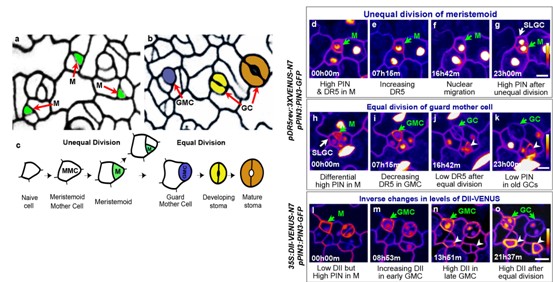Stomata are two-celled valves that control epidermal pores whose spacing optimizes shoot-atmosphere gas exchange. They arise via unequal divisions of stem cells whose frequency and placement regulates stomatal number, density, and their minimal-one-celled separation pattern. The concentration of the hormone auxin, a master plant developmental regulator, is tightly controlled in time and space, but its role, if any, in stomatal formation is obscure. Here we show dynamic changes in auxin activity during stomatal development using time-lapse imaging. We found that auxin transport and signaling enforce stomatal patterning as well as the size of their stem cell compartment.
Stomatal development is a remarkably accessible and rich model system that has already yielded impressive advances in plant developmental biology, such as the regulation of cell fate, division, differentiation, and patterning. The first paper on the molecular genetics of stomatal development (Nadeau and Sack, Science, 2002) showed that patterning results from the orientation of the plane of asymmetric division, a minimal one-cell spacing pattern that is mediated by ligand-receptor signaling. Recent studies on brassinosteroids show that this hormone also regulates stomatal number and patterning (Kim et al. 2012 Nature; Gudesblat et al., NCB, 2012). Here we show that auxin transport and signaling are required for stomatal development and patterning.
Key findings: Dynamic changes of auxin activity during stomatal development by monitoring DII-VENUS (auxin signaling input marker) and DR5:VENUS (auxin response output marker) fluorescence using time-lapse microscopy. This work demonstrates three novel and significant findings. (1) Disrupting auxin efflux prolongs the duration of the transition of successive precursor cells (Meristemoids-to-GMCs). (2) Mutations in genes encoding auxin efflux carriers (e.g. PINs) or in those of signaling receptors (e.g. TIR1/AFBs), leads to the abnormal formation of excessive numbers of stomatal lineage stem cells and to violations in stomatal patterning. (3) The loss of GNOM function, like the application of Brefeldin A, disrupts cell fate by converting unequal divisions in stem cells into equal ones resulting in both daughter cells abnormally developing into stomata.
Above findings have been published recently on Nature Communications (5:3090, doi:10.1038/ncomms4090).
Prof. Le and Prof. Sack are co-correspondence authors of this article. This work has been supported by the Chinese Academy of Sciences,National Basic Research Program of China, and the National Natural Science Foundation of China.
Link: http://www.nature.com/ncomms/2014/140127/ncomms4090/full/ncomms4090.html.

Figure. Auxin Transport and Activity Regulate Stomatal Patterning and Development.
Stomata are two-celled valves that control epidermal pores whose spacing optimizes shoot-atmosphere gas exchange. They arise via unequal divisions of stem cells whose frequency and placement regulates stomatal number, density, and their minimal-one-celled separation pattern. The concentration of the hormone auxin, a master plant developmental regulator, is tightly controlled in time and space, but its role, if any, in stomatal formation is obscure. Here we show dynamic changes in auxin activity during stomatal development using time-lapse imaging. We found that auxin transport and signaling enforce stomatal patterning as well as the size of their stem cell compartment.
Stomatal development is a remarkably accessible and rich model system that has already yielded impressive advances in plant developmental biology, such as the regulation of cell fate, division, differentiation, and patterning. The first paper on the molecular genetics of stomatal development (Nadeau and Sack, Science, 2002) showed that patterning results from the orientation of the plane of asymmetric division, a minimal one-cell spacing pattern that is mediated by ligand-receptor signaling. Recent studies on brassinosteroids show that this hormone also regulates stomatal number and patterning (Kim et al. 2012 Nature; Gudesblat et al., NCB, 2012). Here we show that auxin transport and signaling are required for stomatal development and patterning.
Key findings: Dynamic changes of auxin activity during stomatal development by monitoring DII-VENUS (auxin signaling input marker) and DR5:VENUS (auxin response output marker) fluorescence using time-lapse microscopy. This work demonstrates three novel and significant findings. (1) Disrupting auxin efflux prolongs the duration of the transition of successive precursor cells (Meristemoids-to-GMCs). (2) Mutations in genes encoding auxin efflux carriers (e.g. PINs) or in those of signaling receptors (e.g. TIR1/AFBs), leads to the abnormal formation of excessive numbers of stomatal lineage stem cells and to violations in stomatal patterning. (3) The loss of GNOM function, like the application of Brefeldin A, disrupts cell fate by converting unequal divisions in stem cells into equal ones resulting in both daughter cells abnormally developing into stomata.
Above findings have been published recently on Nature Communications (5:3090, doi:10.1038/ncomms4090).
Prof. Le and Prof. Sack are co-correspondence authors of this article. This work has been supported by the Chinese Academy of Sciences,National Basic Research Program of China, and the National Natural Science Foundation of China.
Link: http://www.nature.com/ncomms/2014/140127/ncomms4090/full/ncomms4090.html.

Figure. Auxin Transport and Activity Regulate Stomatal Patterning and Development.
